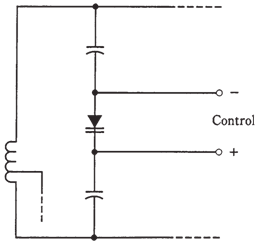The voltage-controlled oscillator
The frequency of a VFO is adjusted by a varactor diode in tuned LC circuit. The capacitance depends on reverse-bias voltage. Greater this voltage, lower the value of the capacitance.
Hartley and Clapp oscillator circuits lend themselves to varactor diode frequency control. The varactor is placed in the series or parallel with tuning capacitor, and is isolated for direct current by blocking capacitors.. The resulting oscillator is termed as voltage controlled oscillator (VCO).

Figure-- Connection of a varactor in a tuned LC circuit.
Why control the frequency of an oscillator in this way? It is commonly done in mod- ern communications equipment; there must be a reason. In fact there are several good reasons why varactor control is better than the use of mechanically variable capacitors or inductors. But it all comes down to basically one thing: Varactors are cheaper. They’re also less bulky than mechanically variable capacitors and inductors.
Nowadays, many frequency readouts are digital. You look at a numeric display in- stead of interpolating a dial scale. Digital control is often done by a microcomputer. You program the operating frequency by pressing a sequence of buttons, rather than by ro- tating a knob. The microcomputer might set the frequency via a synchro on the shaft of a variable capacitor or inductor. But that would be unwieldy. It would also be ridiculous, a “Rube Goldberg” contraption. A varactor can control the frequency without all that nonsense.